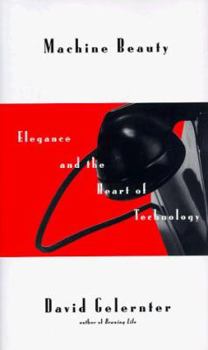Machine Beauty: Elegance and the Heart of Technology
Select Format
Select Condition 
Book Overview
When something works well, you can feel it; there is a sense of rightness to it. We call that rightness beauty, and it ought to be the single most important component of design.This recognition is at... This description may be from another edition of this product.
Format:Hardcover
Language:English
ISBN:0465045162
ISBN13:9780465045167
Release Date:January 1998
Publisher:Basic Books
Length:176 Pages
Weight:0.92 lbs.
Dimensions:0.8" x 5.9" x 9.5"
Customer Reviews
5 ratings
Beauty is truth- so far as I can understand it
Published by Thriftbooks.com User , 17 years ago
This book finds Beauty in a place where it is not ordinarily thought of as being- in the design of machines. It attempts to show how beauty 'drives the computer revolution' "how lust for beauty and elegance underpinned the most important discoveries in computational history and continues to push research onward today." As Gelertner defines it beauty comes of the combination of 'simplicity and power'. And the experience of it can be found even if one is not an engineer . He gives examples like hitting 'with one graceful hammer stroke ' a nail into a board, or making a beautiful catch in baseball, with ease and grace. He says that in such beautiful actions there is no 'superflous motion'. He gives examples from a wide variety of fields to illustrate this principle. "Vigorous writing is concise" he says quoting William Strunk". If I understand him 'beauty' is a kind of rightness in the way a thing is done or designed . This seems to me an interesting definition though of course far from an all- encompassing one of 'beauty'. However when Gelertner began actually comparing computer programs and designs, Apple vs. Microsoft for instance. I did not really get what was going on. I did not have the knowledge and experience to really understand or evaluate this.
Wonderful reading
Published by Thriftbooks.com User , 20 years ago
I am reading Gelernter in backwards order, also recommend Muse in the Machine
Beauty as a Means of Handling Complexity
Published by Thriftbooks.com User , 23 years ago
Modern engineering systems are very complex and must be designed to meet conflicting constraints. The major hurdle facing an engineering designer is to find a way to meet these many competeing contraints in an affordable amount of time at an affordable price. Much work has gone on in computer science on the analysis of systems by formal methods. The hope of these technques is that the entire operation and requirements of a system can be captured in a mathematical model which would allow the 'correctness' of the sytem to its requirements to be proved.This is the major ideas of such distingushed researchers as Hoare and Parnas. Unfortunately these methods have never been found to work in practice. For anything but a toy system the complexity of the formal model becomes intractable. But there is a more important reason for the failure. How can 'correctness' be defined fro a real world system which must work in a filed of changing requirements.Gelernter identifies this problem but notes that it is solved everyday by real world engineers who must face real world requirements. These engineers are not deterred by the failure of formal methods. Instead they rely on a sense of beauty which is a sense gained from experience in how a system can meet its requiremtns. It is this abilty to see though the complexity to see the structure and pattern in the design that will dictate its degree of success that enable a human designer to function where strictly mathematical and logical techniques fail. Only techniques which use holistic thinking can succeed in in the real world.It is often thought that human reaoning pales beside the clarity of logic and mathematics in understanding the world and how devices function. Gelernter rightly points out that this common attitude is precisely worng. Formal mathematical technqiues have failed where they have been claimed to be paramount. The human understanding of beauty is an ability to function in the world by identifying what is most suited to an issue.Gelernter seems to be saying that the quest of many people to reduce the world to mathematics can only result in failure. It is confusing certainty with knowledge. Experience has shown that these technqiues cannot cope with real world complextity. The proponents of such techniques often portray themsleves as realisitc pragmatists who confront the problem which others try to avoid. Gelernter shows that these people are blind to the real problem and exhibit an unjustified faith in cold specific logic. Only techniques which can view the problem and proposed solutions holistically can hope to cope with real world complexity. It are these technqiues which supposed pragmatists heap scorn on which are most practical. It is poetry and not mathematics which bests describes the world.This book is worth reading.
A thought-provoking and enjoyable read
Published by Thriftbooks.com User , 25 years ago
I've just read this book (at least I think I've just read it -- the book I just read by David Gelernter was called "The Aesthetics of Computing" and was bought in the UK). I found the book a fascinating read. There is a lot of "energy" and there are many interesting ideas on every page. I think it has parallels with Christopher Alexander's work on patterns.I don't think the book deserves such strong negative comments given in other Customer Reviews. I think it is well worth the $$$!
Right on!
Published by Thriftbooks.com User , 26 years ago
Gelernter knows his stuff. The other 99% don't have a clue. Read this one with Johnson's "Interface Culture", wrap it all up with McKennas's "Real Time", and you're ready for 2001, maybe even 2101... :-)





